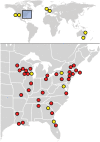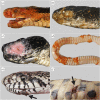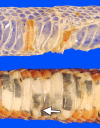Snake fungal disease: an emerging threat to wild snakes
- PMID: 28080983
- PMCID: PMC5095536
- DOI: 10.1098/rstb.2015.0457
Snake fungal disease: an emerging threat to wild snakes
Abstract
Since 2006, there has been a marked increase in the number of reports of severe and often fatal fungal skin infections in wild snakes in the eastern USA. The emerging condition, referred to as snake fungal disease (SFD), was initially documented in rattlesnakes, where the infections were believed to pose a risk to the viability of affected populations. The disease is caused by Ophidiomyces ophiodiicola, a fungus recently split from a complex of fungi long referred to as the Chrysosporium anamorph of Nannizziopsis vriesii (CANV). Here we review the current state of knowledge about O. ophiodiicola and SFD. In addition, we provide original findings which demonstrate that O. ophiodiicola is widely distributed in eastern North America, has a broad host range, is the predominant cause of fungal skin infections in wild snakes and often causes mild infections in snakes emerging from hibernation. This new information, together with what is already available in the scientific literature, advances our knowledge of the cause, pathogenesis and ecology of SFD. However, additional research is necessary to elucidate the factors driving the emergence of this disease and develop strategies to mitigate its impacts.This article is part of the themed issue 'Tackling emerging fungal threats to animal health, food security and ecosystem resilience'.
Keywords: North America; Ophidiomyces ophiodiicola; dermatitis; emerging disease; fungal infection; snake.
© 2016 The Author(s).
Figures



References
-
- Turner GG, Reeder DM, Coleman JTH. 2011. A five-year assessment of mortality and geographic spread of white-nose syndrome in North American bats and a look to the future. Bat Res. News 52, 13–27.
-
- Clark RW, Marchand MN, Clifford BJ, Stechert R, Stephens S. 2011. Decline of an isolated timber rattlesnake (Crotalus horridus) population: interactions between climate change, disease, and loss of genetic diversity. Biol. Conserv. 144, 886–891. (10.1016/j.biocon.2010.12.001) - DOI
Publication types
MeSH terms
Associated data
LinkOut - more resources
Full Text Sources
Other Literature Sources

